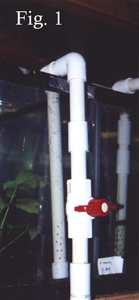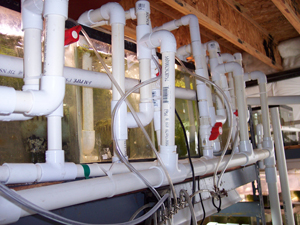|
The limiting factor
in keeping an aquarium, and certainly multiple
tanks, is your
ability to provide consistent,
substantial water changes where water is removed and replaced
from the aquarium. Topping off alone is not
adequate- by doing so you are simply raising the
concentration of toxic substances in the water over time.
A minimum on a stand alone display tank is about 20- 30% a
month, but about 20% a week would be best. Here,
an automatic water change system
changes about 15% of the water every day. Generally, you can add
up to 40%
of a tank's volume with tap water to an established aquarium
without harming the fish- the chlorine concentration
in your water may vary. Always make sure that the water you
add is the same temperature as the water the fish
are in, and it is best to dechlorinate the water if possible.
The First Water Change System
Begun in a modest form in 2000, the first
water changing setup used PVC lines connected to a sink to the
tanks that both filled and drained. It worked well, but
became unwieldy after the room grew to larger than
20 tanks. The siphoning of the tanks started automatically,
and I could consistently control the amount of
water going in and coming from the tanks. It is much simpler
than the system that both fills and empties the
tanks, and though it eliminates needing to use buckets and
dramatically shortens the amount of time required
to do water changes on your tank(s), it does require that
someone is present when the tanks are fiiled back up..
Here is that setup
A 1/2" PVC line is installed from a sink to the aquariums(s).
The PVC line follows along the bottom of the
tank(s), and a "T" is installed below each tank so that a
line goes up to and into each tank. A 1/2" PVC
valve is installed at least a foot below the water line of
its tank. The The PVC line would extend from the
valve up and into the tank, extending below the water level
to where the water is desired to be drained
during a water change.
The PVC tube that goes down into each tank is then capped at the
very end, with holes (about 1/16th of an
inch) drilled the last few inches, allowing water to both be
siphoned out and poured in, without sucking
adults or fry into the tubing. After a tank had been filled,
the valve was turned off, and water was held
in the PVC from the valve to the end of the line under water
in the aquarium. When the valve was turned
back on, the water would drain back out. In other words, a
siphon had been created and held until the next
water change. Simply turning the valve back on then caused
the tank to drain back out. After the tanks had
been filled with this setup, the PVC would be disconnected
from the sink faucet for the next water change,
and by turning on a tank's valve, the water from that tank
would then drain out until air hit the holes in
the drain line. The PVC would then be reconnected to the
faucet, and the tank could then be refilled,
turning the water off when the tank had reached the level
you were looking for. Unlike the system described
below, if you do not manually turn off the water, the tank
will overflow.
 A pic of the first Water Change PVC setup.
A pic of the first Water Change PVC setup.
Each tank had one of these PVC lines going into the tank,
extending down to about halfway into the water,
so that each tank would drain down about 50%. When the tank
drained down to where the holes drilled into
the drain line began, air would enter the holes, and it would
stop. The tank would then be refilled and
the process begun again. It was great, but with multiple
tanks filling at the same time a close eye needed
to be kept on the process so that tanks being filled do not
overflow.. Also, when replacing half of the water
in many tanks, all in one session, it became necessary to
stop midway for 3 or 4 hours to let the hot water
heater reheat- or the last tanks simply got cold water,
which would stun and possibly kill the fish. For
simplicity with fewer tanks this is still a great way to
install a water change system, but for someone
wishing that the system des all of the work (except the
initial construction), this next method is best.
The Updated System (Fully automatic and for
more than a few tanks)
Al Wood (former chairman of the
ALA) brought me a device made
of PVC that would drain an aquarium
from one side of the aquarium while it was
being filled into the other side, and this new device did
not
involve drilling holes in the glass of any
tanks. Over the next 4-5 years the system continued to be
refined
to where it continues to work today
with no drilling of tanks and no pumps. Water can be
changed at any
amount, and as frequently as necessary.
Changes of 15% per day can be done without concern for
emptying the hot water heater, and it is all done
on timer, automatically, so it is no longer necessary
for anyone to be there when it is being done.
Because less water is being exchanged more frequently,
there is no longer any concern for draining the
hot water heater. In this fishroom of 130 tanks it takes
about 45 minutes to do a 15% water change
on all of the tanks.
The sprinkler system timer can be overridden easily when it
is best to do the water change with someone
present - otherwise the room is done entirely on its own.
Below is a photo behind a small section of upper
row tanks. A copy of the manual fully
describing how to build and install this system, with
information on how
to avoid having water cross between tanks,
is now available for download HERE. The
only maintenance
involves the very rare times when a tank loses its siphon,
generally because a tank had been drained
down to clean it, and the siphon had not been properly
restarted. Also, joints that had not been
adequately glued initially, or that have dried out over many
years will develop a slow drip leak,
which are easily repaired. Because there is no drilling of
glass, tanks can be easily removed or added,
and changes to the system can be done easily.
Back to Previous Tips
To Next Tip
 The current system with both drain
and fill lines.
The current system with both drain
and fill lines.
Home
Contact Us
Receiving Shipped Fish
Keeping Select
Aquatics Fish |
 |

 A pic of the first Water Change PVC setup.
A pic of the first Water Change PVC setup. The current system with both drain
and fill lines.
The current system with both drain
and fill lines.